Final report for SW20-913
Project Information
Thousand cankers disease (TCD) is a threat to English walnut (Juglans regia) and Paradox rootstock in California orchards, to California native walnut species, and to eastern black walnut in forests, plantations, and landscapes throughout the USA. TCD is caused by a fungal infection following attack by the walnut twig beetle (WTB, Pityophthorus juglandis), which aggregates and transmits the pathogen, Geosmithia morbida. Multiple infections girdle and kill branches and stems, with TCD often becoming lethal to the tree. Current management options are only partially effective and are limited to general cultural practices (i.e., maintain tree vigor) and sanitation of infested materials. Successful TCD management in orchards must include a more targeted strategy that includes the capacity to determine which host trees are likely to become infected and the ability to detect and deter the vector. Chemical ecology studies of the interaction between the WTB, pathogen, and plant host have identified an aggregation pheromone-based lure for WTB detection and repellent compounds to disrupt WTB host location, feeding behavior, and aggregation. This project extended our studies to further evaluate an optimized lure and a repellent mixture, including a trial in a commercial orchard. Common bacterial root, crown and stem diseases of walnut are often associated with TCD-affected trees. In orchard surveys, we determined the strength of the association between crown gall disease and severity of beetle attack and TCD incidence. This information clarifies anecdotal observations and provides clearer understanding of the association between crown gall as a potential predisposing stress and TCD that may guide grower deployment of WTB lures and repellents. The unforeseen challenges described elsewhere in our report severely impacted project execution throughout the performance period. Education and outreach to walnut producers, PCAs, and other stakeholders was limited to a webinar, publications, and available online resources. Nonetheless, our statewide network of UCCE orchard systems advisors who work with walnut growers remain engaged and will continue to provide latest research findings and recommendations on TCD to clientele. The principal outcome of this project will be enhanced competitiveness through increasing sustainability and resilience of walnut orchards as indicated by demonstration of an effective lure to monitor WTB populations and repellents to disrupt aggregation behavior. These fit well within an integrated pest management program, with potential for large-scale development and adoption by growers throughout California and elsewhere.
Note: The COVID pandemic forced closure of our laboratories during the first three months of the grant and continued to constrain staffing, travel, and education and outreach efforts throughout. Record-breaking wildfires in the region during 2020 prevented fieldwork and trapping studies during periods when WTB are normally most active (smoke inhibits them), delaying field experiments until 2021. Supply chain issues in repellent availability and other materials also caused unanticipated delays. The death of Dr. Seybold prior to the start of the project and consequent loss of his expertise, research facilities, collegiality and energy created an insurmountable void throughout the project. COVID-related challenges also impacted personnel, resulting in staffing changes and revisions to the project scope. Changes in the following sections are incorporated, with further explanation in the Results and Discussion section.
Four objectives, modified from the original plan, were pursued that underscore the overall goal of developing effective management tools for TCD. Objective 1: Field test a repellent mix for disrupting WTB aggregations and protecting trees from attack in experimental orchards and a commercial orchard. Objective 2: Determine if tumor-emergent WTB carry crown gall bacteria. Objective 3: Develop a tree risk-rating system based on association between TCD incidence and occurrence of crown gall disease. Objective 4: Conduct education and outreach with input from our producer cooperators and UCCE Orchard Systems farm advisors to the extent possible within restrictions imposed by the pandemic and within health department and university policy. The research was largely conducted in the Bostock lab (UCD), with support from members of the Kluepfel lab (USDA ARS). Dr. Fichtner served as Extension/Outreach Representative. Although not formally listed as a cooperator, Dr. Kari Arnold, UCCE Area Orchard and Vineyard Systems Farm Advisor, Stanislaus County, contributed to outreach and education efforts. Researchers supported by the grant include Megan Siefker (Lab Assistant, June 2020-September 2022), Jason Simmons (graduate student; April 2020-March 2021), and Dr. Corwin Parker (post-doctoral associate; January-December, 2021).
Note Modified Project Timeline: Field testing of the WTB repellent was a central activity of this project (Objective 1). Ms. Siefker and Dr. Parker oversaw this work, which was delayed until year 2 (2021). Following Dr. Parker’s departure in January, 2022, Ms. Siefker, with assistance of Dr. Bostock, continued this work in spring, 2022. Trials in several orchards and associated data analysis were completed in late summer 2022, a major milestone. Objective 2, the impact of crown gall disease on incidence and severity of TCD was directed by Dr. Bostock and Dr. Ali McClean, a member of Dr. Kluepfel’s laboratory. We determined that tumor-emergent WTB carried crown gall bacteria, an important milestone and discovery. Objective 3 concerned developing an orchard risk-rating system informed by orchard surveys. Objective 4 was the education/outreach component of the project, and was cooperative effort of Drs. Bostock and Parker and UCCE Farm Advisors, but was very limited in scope. All project objectives departed significantly from what was originally proposed and outlined in the original Gantt Chart, with reduced scope for reasons indicated above.
Cooperators
- - Producer
- (Researcher)
- - Producer (Educator)
- - Producer
- (Researcher)
- - Producer
Research
The central hypothesis of this research is that cost-effective deployment of the walnut twig beetle (WTB) repellent for mitigating thousand cankers disease (TCD) in commercial walnut orchards in California will require knowledge of the repellent's range of efficacy from a point source, understanding seasonal patterns in WTB flight behavior, and identification of trees that are most at risk of attack by WTB.
As originally conceived, objective 1 was to focus on i) characterizing semiochemicals that attract or disrupt WTB aggregations, and ii) field-testing lure and repellent mixtures in commercial orchards using methods established in our laboratories (Audley et al. 2020b; Homicz et al. 2021). However, we had to narrow our focus to only study the repellent. Flight responses were measured by trap catches to the standard lure, the hemiterpenoid 3-methyl-2-buten-1-ol (MBO), which works well. We had field-tested known WTB repellents in various combinations (Audley et al. 2020a; Audley et al. 2020c), which were evaluated at defined release rates for their potential to reduce flight response to MBO-baited traps (positive control). The purpose of these experiments was to assess the repellent as a potential behavioral disruptant to reduce WTB colonization and damage to trees. Based on trapping results, commercial availability, and cost of the semiochemicals tested, we concluded that for the present study a two-compound repellent consisting of R-(+)-limonene and trans-conophthorin would be appropriate to test as a potentially effective tool for protecting trees from colonization by WTB (Audley et al. 2020a; Blood et al. 2018). Note: The experimental procedure as originally proposed was simplified as described below to accommodate limited staffing and a restricted experimental window.
Repellency Study
We tested the range of influence of the WTB repellent over the course of two trials conducted in fall, 2021, and two trials in spring, 2022. The 2021 trials took place in a mixed walnut block at Wolfskill Experimental Orchards in Winters, Solano Co., CA, USA (38.500361°N, 121.977424°W) and in two Juglans regia (English walnut) blocks at the Armstrong Plant Pathology Research Field in Davis, Yolo Co., California (38.520749°N, 121.758918°W) from September 1st to October 19th 2021 (7 weeks). The 2022 trials took place at the same mixed walnut block at Wolfskill Experimental Orchards and a J. regia orchard at Lester Farms, Winters, Solano Co., California (38.496130°N, 121.980990°W) from April 6th through June 22nd 2022 (11 weeks).
Before beginning the experiments in 2021, we set out 6 funnel traps at Wolfskill and 4 at Armstrong to monitor WTB populations in areas around the orchard where we wanted to set up trap circuits. We found that overall trap catches at Armstrong were significantly lower than Wolfskill. Trapping materials and methods were modeled after S.J. Seybold’s guideline for detecting and identifying the walnut twig beetle (http://ipm.ucanr.edu/PDF/PESTNOTES/WTB_trapping.pdf) and described in Chen and Seybold, 2014. Black, plastic, 4-unit Lindgren funnel traps (wet cup style) were suspended on 10 ft steel conduit poles placed over 4 ft rebar rods hammered into the soil. Each trap was baited with a WTB bubble cap lure containing the WTB aggregation pheromone 3-methyl-2-buten-1-ol (MBO) purchased from Synergy Semiochemicals, Delta, BC, CAN).
The repellent was prepared as prescribed by Audley et al. (2020), but modified as follows. To minimize cost, we did not include verbenone in the repellent tests since it showed to be the least effective compound in the earlier studies. Instead, our repellent consisted of a commercially available 250 μl high release trans-conophthorin (Synergy Semiochemicals) packaged in a 400 μl polyethylene tube inside an opaque plastic pouch, and 15 ml (R)-(+)-limonene (Sigma-Aldrich, Inc., St. Louis, MO) placed into 15 ml low-density polyethylene screw cap bottles (SKS Bottle & Packaging, Inc., Saratoga Springs, New York) (Figure 1). Chemical components were suspended with copper bell wire (Home Depot) inside the 3rd funnel from the top of the trap. (Bell wire from Home Depot: https://www.homedepot.com/p/Cerrowire-65-ft-20-2-Solid-Copper-Bell-Wire; Model# 206-0101BA3)
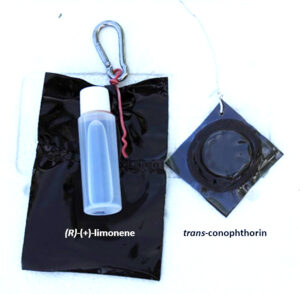
In the repellency trials conducted in 2021, trapping stations were set up at the two test sites, Wolfskill and Armstrong Experimental Farm. The Armstrong site had two stations on the east side of the property and two stations in a separate J. regia block on the west side of the property (both blocks are J. regia but are different varieties, Chandler and Tulare). The Wolfskill site had the remaining 6 trapping stations for a total of 10 trapping stations across both sites. At Wolfskill, most stations were set up near declining Juglans hindsii trees (Northern California black walnut) where we suspected beetle activity to be higher given the increased susceptibility of this species to attack by WTB. Trap stations 3 and 4 at Wolfskill were located in a section of the walnut orchard where the trees had died but where we were still catching a sufficient number of WTB as determined by the monitoring traps set up prior to this experiment.
Each station was comprised of 5 traps: one center trap that served as either a control or a repellent treatment, with two traps 2m away and two traps 4m away from the central trap (Figure 2). The peripheral traps were positioned at 90-degree angles from one another to maximize distance between traps and minimize interference from overlapping WTB aggregation pheromone. The 2m traps were always 180° from each other as were the 4m traps. Traps were positioned among the trees in the orchard with the center trap stationed between two trees, in line with the orchard row. The peripheral traps extended into the center between the tree rows, making it a challenge for mowers to maneuver around but fortunately our collaborators were accommodating. All trap stations were over 30 feet (~10 m) apart from each other.
All traps were baited with the MBO aggregation pheromone bubble cap release devices with only the central traps carrying the repellent lure if assigned as a treatment. Treatments and controls were randomized within each site using a random number generator (random.org) and just the repellents (not the whole traps) were moved according to that designation.
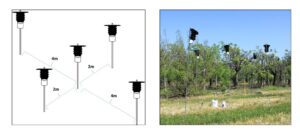
Funnel traps were emptied once a week. Contents were poured out of the wet cups and antifreeze was filtered out using a paint strainer over an empty plastic yogurt container. Antifreeze was reused unless it was dirty and gelatinous. Contents of trap cups were kept in the paint strainer, gently folded closed at the top, and placed into a plastic ziplock bag with premade paper labels indicating trap station #, trap #, location, and date range in the field. The interior surface of the bottom funnel as well as the rim of the collection cups were wiped down with a Lysol wipe in between collections to prevent dirt buildup and spider webs.
Antifreeze specs: STAR BRITE–WinterSafe -50°F Professional Grade Antifreeze, Gallon, Ethanol-free formula (https://www.westmarine.com/star-brite-wintersafe--50f-professional-grade-antifreeze-gallon-10932804.html).
Funnel trap samples were analyzed under a dissecting microscope. Male and female WTB were counted and separated according to sex following guidelines from Seybold et al. 2013. We also tallied other associated insects of note such as Xyleborinus saxeseni (fruit tree pinhole borer) and Hypothenemus eruditus, which are commonly also found in the traps.
Statistical analyses: Pairwise comparisons of treated (repellent + MBO bait) and untreated (MBO bait only) plots were performed in R using Student’s t-test. Traps were categorized based on their distance from the treated or untreated central trap, and compared within these categories. For example, all traps 4 m away from the central trap were compared against each other using repellent presence as the dependent variable. The analysis was conducted separately for all study site locations, and for separate years, as well as with datasets with the sites and years concatenated. A critical significance value of α = 0.05 was used for all analyses.
Crown gall disease and TCD
Crown galls appear to have a capacity to provide a substrate for enhanced development of new WTB adults. In objective 2 of this study, the potential direct association of WTB with crown gall bacteria was examined by processing tumor-emergent WTBs for the presence of A. tumefaciens with both an A. tumefaciens selective isolation medium and species-specific PCR (Yakabe et al. 2012).
The first group of crown gall samples was collected from an orchard farmed by J.H. Meek & Sons, Inc., in Woodland, Yolo Co., California on November 5, 2021 (38.60090°N, 121.78383°W). Our contact was Andrew Rumsey, the PCA for this producer, of Grow West. Galls were excised from rootstocks with a reciprocating saw, and in some instances with a chisel and rubber mallet. Cutting surfaces of the implements were sprayed before and after use with 70% ethanol. Fresh crown gall tissue with signs of WTB holes were chosen and collected from multiple trees on Paradox rootstock (Figure 3), and placed in 5-gallon buckets for transport to the laboratory.
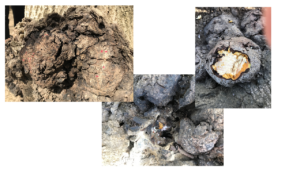
Gall material was divided across 8 plastic transparent rearing cages (~27x19x10 cm; Pioneer Plastics, Dixon, KY; SKU 195C) with a detachable lid and two 6 cm-diameter ventilation holes sealed with a mesh screen to prevent insects from escaping. Rearing cages were thoroughly washed and sanitized with 70% alcohol prior to adding crown gall material. In cases where gall material was fresh, damp, and likely to mold, we removed the plastic lids, placed a layer of fine mesh material over the top and closed it off with a large rubber band. We also included silica gel packs to reduce moisture buildup. Approximately twice a week, boxes were emptied one at a time and any loose contents were swept into a sterile petri dish and analyzed under a dissecting scope. Any live, emerging beetles were collected with sterile larval forceps and gently placed on selective 1A medium, where they typically walk around. Plates were sealed with Parafilm, labeled with box number, date, number of male and female WTB on the plate, and then placed in plastic containers at room temperature. Indications of Agrobacterium could be seen within a few days and the plates were then delivered to the Kluepfel lab for PCR testing. Bacteria were identified by 16S sequence analysis, and Agrobacterium tumefaciens positive isolates were examined for presence of Ti plasmid and virulence by Tip6 PCR, as described by Yakabe et al., 2012.
The second collection of crown galls occurred on April 26, 2022, from walnut trees within the New Stuke block, an experimental orchard with mixed species and varieties at UC Davis, located in Davis, Yolo Co., California, (38.539115°N, 121.796222°W). At this site, crown gall material was removed from 10 different Juglans sp. trees and placed into individual brown paper bags to keep the species/varieties separated. Galls from each tree were placed into their respective plastic rearing cages and labeled with the date/tree ID. Any emerging WTB were collected and plated and analyzed in the same manner as the previous trial.
In objective 3, we sought to determine if infection by the crown gall pathogen, Agrobacterium tumefaciens, influences host apparency and susceptibility to WTB attack. Anecdotal field observations and preliminary surveys, one conducted in a commercial orchard of project cooperator Al Albertson, indicated attack by WTB and severity of TCD is often higher in orchards with a history of crown gall (Seybold et al. 2016). Thus, there is risk-rating potential for this disease to serve as an indicator for predisposition of trees to attack by WTB and subsequent long-term decline of tree health. In this study, a systematic survey was conducted at the English walnut orchard owned by J.H. Meek & Sons in Woodland, Yolo Co., California, approximately 1 km north of the intersection of County Roads 29 and 99 (38.599509°N, 121.783811°W) from late April (4/26/2021) to early June (6/9/2021) 2021. The walnut orchard was comprised of Juglans regia, Chandler variety, grafted onto mostly Paradox rootstock (J. regia X J. hindsii) with some trees on black walnut (J. hindsii) rootstock. This mature orchard was ideal for our survey as it had a heavy presence of crown gall (Figure 4). We assessed incidence and severity (measured as stem gall circumference) of crown gall disease, TCD symptoms expressed as staining of branches, scion trunk, and rootstock, and number of WTB entry/emergence holes.
We selected 200 trees at random (random.org) from a 50x50 tree grid of the northwestern portion of the orchard. Diameter at breast height was recorded using a D tape, and values ranged from 4.7-15.7 DBH. We did not include trees that were too small or dead. If one of our random tree numbers was a replant or dead or missing, we would select the next tree in the row. Individual TCD stains were counted to the best of our ability at three separate sections of the trees: the rootstock, scion, and all branches in the canopy that were visible from our perspective. In many cases, trees were heavily inundated with stains. To minimize time spent counting hundreds of stains we chose to rank trees according to a severity rating of 0-3 with 0 indicating no stains at all, 1= 1 to 10 stains, 2=11 to 100 stains, and a severity rating of 3 having greater than 100 stains. Exact counts of stains were recorded when possible but they were often estimated when over 50 stains. A red, oil-based Sharpie* paint pen was used to mark off stains on the trees so that they were not double-counted between our surveyors (Figure 3). We planned to take note of other potential staining from shallow bark canker or lethal paradox canker but did not encounter these diseases in our randomized survey.
*Sharpie pen description (https://www.sharpie.com/markers/chalk-paint-markers/sharpie-oil-based-paint-markers-medium-point/SAP_1875038.html) medium point marker.
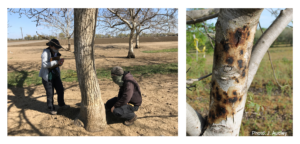
WTB holes (i.e., entrance/emergence holes; these holes are a sign of attempted and completed reproduction by WTB) were documented in a similar fashion as TCD stains. However, since holes could not be seen in the tree canopy, they were instead recorded from rootstock tissue, crown gall tissue, and the scion of the tree where they were most visible. We decided to differentiate between healthy rootstock tissue and crown gall tissue on the rootstock because beetle activity seemed concentrated in the crown galls. Hole counts were assigned a 0 to 3 severity rating the same as TCD stains. Crown gall severity was determined by visually estimating the percent circumference of crown gall tissue on the rootstock from 0-100%. Of the 100 walnut trees we surveyed, 57 had crown gall disease.
Statistical analyses: A Spearman’s rank correlation was performed to determine the relationship between crown gall severity (% circumference) and TCD severity in terms of stains and WTB holes. For each tree, the individual ratings for stains in the branches, scion, and rootstock were added to create a composite score for stains, as were the ratings for WTB holes in the rootstock, galls (if present), and scion to create a composite score for WTB holes. The values for crown gall severity, and WTB stains and holes were then ranked. In addition, DBH values were ranked, and correlation analysis conducted to determine the relationship between crown gall severity and DBH, as well as TCD and DBH. Using the ranked values, the nonparametric Spearman ρ (correlation coefficient) and correlation probabilities were determined with the multivariate regression platform in JMP Pro (ver. 16.0; SAS Institute).
Publication of studies relevant to project. Four papers were published in peer-reviewed journals, appearing during the first year (2020) of the project. The studies reported in these papers, supported mostly from prior funding, were central to the continuing studies on the repellent and the main theme for this project. A fifth paper, a new isothermal PCR assay we developed for in situ detection of Geosmithia morbida in TCD-afflicted walnut trees, was submitted to Plant Disease in late 2020. The paper was recently revised to add additional experimental results and will be resubmitted soon. We are also preparing a manuscript for journal publication of the research recently completed from this project. The following papers were published:
Audley JP, Bostock RM, Seybold SJ. 2020. Trap assays of the walnut twig beetle, Pityophthorus juglandis Blackman (Coleoptera: Curculionidae: Scolytinae), reveal an effective semiochemical repellent combination. J. Chem. Ecol. 46:1047-1058.
Audley JP, Homicz CS, Bostock RM, Seybold SJ. 2020. A study of landing behaviour by the walnut twig beetle, Pityophthorus juglandis, among host and nonhost hardwood trees in a northern California riparian forest. Agric. For. Entomol. 22:338-348.
Audley JP, Dallara PL, Nelson LJ, Hamud SM, Bostock RM, Seybold SJ. 2020. Trapping failure leads to discovery of potent semiochemical repellent for the walnut twig beetle. J. Econ. Entomol. 113:2772-2784.
Homicz CS, Audley JP, Chen Y, Bostock RM, Tauber CA, Seybold SJ. 2021. Walnut twig beetle landing rates differ between host and nonhost hardwood trees under the influence of aggregation pheromone in a northern California riparian forest. Agric. For. Entomol. 23:111-120.
Accepted with revision:
Simmons JD, Yaghmour MA, Seybold SJ, Bostock RM. Development of a recombinase polymerase amplification assay with qualitative end-point detection for Geosmithia morbida, the causal agent of thousand cankers disease in walnut. Plant Dis. (in revision)
In addition, Jason Simmons completed the M.S. degree in Plant Pathology on 31 March 2021 with thesis of the same title as the above manuscript.
Trapping of WTB to document seasonal patterns. We processed a backlog of trap catches from walnut twig beetle (WTB) flight monitoring projects that took place in walnut orchards at Wolfskill Experimental Orchards in Winters, CA and the Armstrong Plant Pathology Research Field in Davis, CA between 2013 and 2019. These samples were collected from 4-unit Lindgren funnel traps baited with the MBO male aggregation pheromone of WTB. Four traps from each site were emptied weekly and saved in labeled ziplock bags. Trap catches were sorted under a dissecting scope and counts of male and female WTB as well as other associated insects were recorded. Samples were collected at these sites over an 8-12 month period, depending on the year, but all years included sampling from spring through fall when WTB are most active. While many of these samples were processed immediately after collection, a large number of them were placed in cold storage and recovered in early 2020 after the passing of Dr. Seybold. Processing these samples was important because data from these long-running experiments identified peak flight trends, enabling us to maximize WTB trapping numbers at experimental sites for repellent trials. Figure 5 captures annual trends at the two sites for the 2015 to 2019 trapping seasons, the most complete trapping datasets.
It is apparent from the graphs that there is variation between years, between sites, and among traps within sites, but there are general trends. There is a peak flight period beginning late May/early June that often extends into July. There can also be another period of flight activity later in the summer, beginning in August and extending through late October. In some years, there was another upsurge in WTB activity in early spring (March-April) at the Wolfskill site.
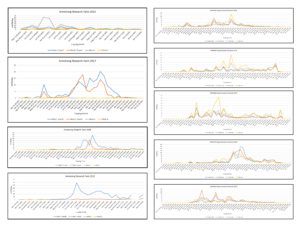
Objective 1. Repellent field tests. COVID restrictions and regional wildfires in 2020 (WTB flights are inhibited by smoke) prevented field assessments of repellent efficacy until 2021. Trials were conducted at three sites: Wolfskill Experimental Orchards (2021 and 2022), the Armstrong Plant Pathology Research Farm (2021), and a commercial orchard (2022). Trapping numbers for WTB were highest at the Wolfskill site in both years, and thus provide the most robust dataset. The results, combined for all sites and both years, are presented in Figure 6.
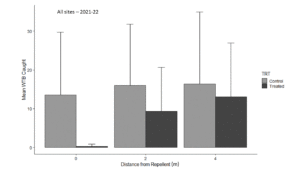
Figure 6 - repellent summary.pdf
Table 1 presents statistical analysis of the data by distance from repellent and parsed by year and site. In the presence of the aggregation pheromone MBO, the repellent cocktail of R-(+)-limonene and trans-conophthorin has an effective distance of 2 meters from the point source, and in some cases may be effective up to 4 meters. This is consistent with our view that in order to be cost-effective, any deployment of the repellent in orchards will likely target single trees identified as high-risk during periods of peak WTB flights (see Objective 3).
| Year, Site | Distance from repellent (M) | ||
| 0 | 2 | 4 | |
| 2021+2022, All Sites | 7.15E-10* | 3.83E-05* | 0.0825 |
| 2021+2022, Wolfskill | 2.34E-08* | 4.79E-05* | 0.03619* |
| 2021, Both Sites | 1.34E-06* | 4.81E-05* | 0.07833 |
| 2021, Wolfskill | 0.0002* | 2.71E-07* | 0.006763* |
| 2021, Armstrong | 0.0003* | 0.3183 | 0.5392 |
| 2022, Both Sites | 4.01E-06* | 0.01375* | 0.317 |
| 2022, Wolfskill | 6.37E-06* | 0.01367* | 0.2948 |
| 2022, Lester Orchard | 0.004883* | 0.03396* | 0.889 |
Table 1. Statistical significance of differences between control and repellent treatments in WTB trap catches by distance from the repellent in the trials conducted at three sites in 2021 and 2022. A critical significance value of α = 0.05 by Student’s t-test was used. *indicates significant difference.
Walnut bark chemistry. Although several hundred bark samples, including samples from both G. morbida-inoculated and non-inoculated trees, were obtained from Juglans major, Juglans californica, and ‘Paradox’ hybrid rootstock (Juglans regia X Juglans hindsii), and extracted according to protocols described in our original proposal, only a small number of these were analyzed and partially interpreted. The loss from the project of the graduate student researcher responsible for this objective in March 2021, as well as closure of co-PI Seybold’s analytical lab facility, precluded further progress on this aspect. We were unable to continue to pursue the portion of objective 1 concerning walnut bark chemistry and the search for tree host and fungal semiochemicals that influence WTB behavior.
Objective 2: Determine if tumor-emergent WTB can carry crown gall bacteria. Thirty-nine isolates were recovered from the various medium1A plates on which tumor-emergent WTB had been placed, and were further analyzed based on similar colony morphology to the crown gall pathogen, Agrobacterium tumefaciens (Figure 7). Fourteen of the 39 bacterial isolates were identified as A. tumefaciens. However, they were all avirulent based on the absence of the Ti plasmid as determined by Tip6 PCR. Note that most A. tumefaciens bacteria isolated from soil and other sources lack the Ti plasmid (D. Kluepfel). Eleven non-A. tumefaciens isolates were identified as Rhizobium spp. and Agrobacterium spp. based on 16S sequence analysis. These isolates were also Ti plasmid negative based on Tip6 PCR results. Five of these isolates were also evaluated in disease bioassays on Datura seedlings and did not cause any disease symptoms. The 16S results from three remaining sequenced bacterial isolates matched members of other genera (Erwinia, Ochrobactrum, and Beijerinckia, respectively). Twelve additional non-A. tumefaciens isolates were not further characterized.
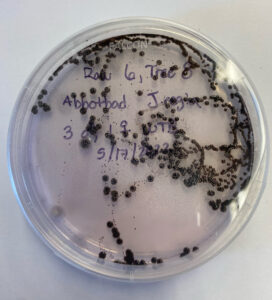
The biological significance of WTB carrying A. tumefaciens with respect to walnut orchard health is unclear, but it seems unlikely that WTB is a vector that can transmit crown gall disease. All the A. tumefaciens we isolated from the tumor-emergent WTB were avirulent. Also, since most WTB carry the TCD pathogen, the rapid necrotic reaction of host tissue during G. morbida infection and colonization would likely preclude tumorigenesis by crown gall bacteria, a process which requires living host cells.
Objective 3: Develop a tree risk-rating system based on association between TCD incidence and occurrence of crown gall disease. We focused on the association between crown gall and TCD because prior observations over the years suggest that trees severely affected by crown gall are often affected by TCD. Although data from three commercial orchards were analyzed, the survey from one of these orchards (J.H. Meek & Sons orchard) was most systematic and thorough, and provided a robust dataset that we present here. This older commercial orchard had a very high incidence of crown gall and significant incidence of TCD. Our survey was conducted during spring and summer of 2021. Although the orchard was commercially viable for many years in spite of the high disease incidence, the grower removed it in 2022. For each tree, we determined diameter at breast high (DBH), and estimated crown gall severity based on the percent of the circumference of the tree base galled, bark staining as a TCD symptom, and WTB strikes. The TCD/WTB severity assessments were parsed for rootstock, scion (main trunk), and visible branch symptoms. ANOVAs on crown gall vs. TCD/WTB severity were performed and the crown gall percent vs. TCD/WTB severity data are summarized in Figures 8 A-E.
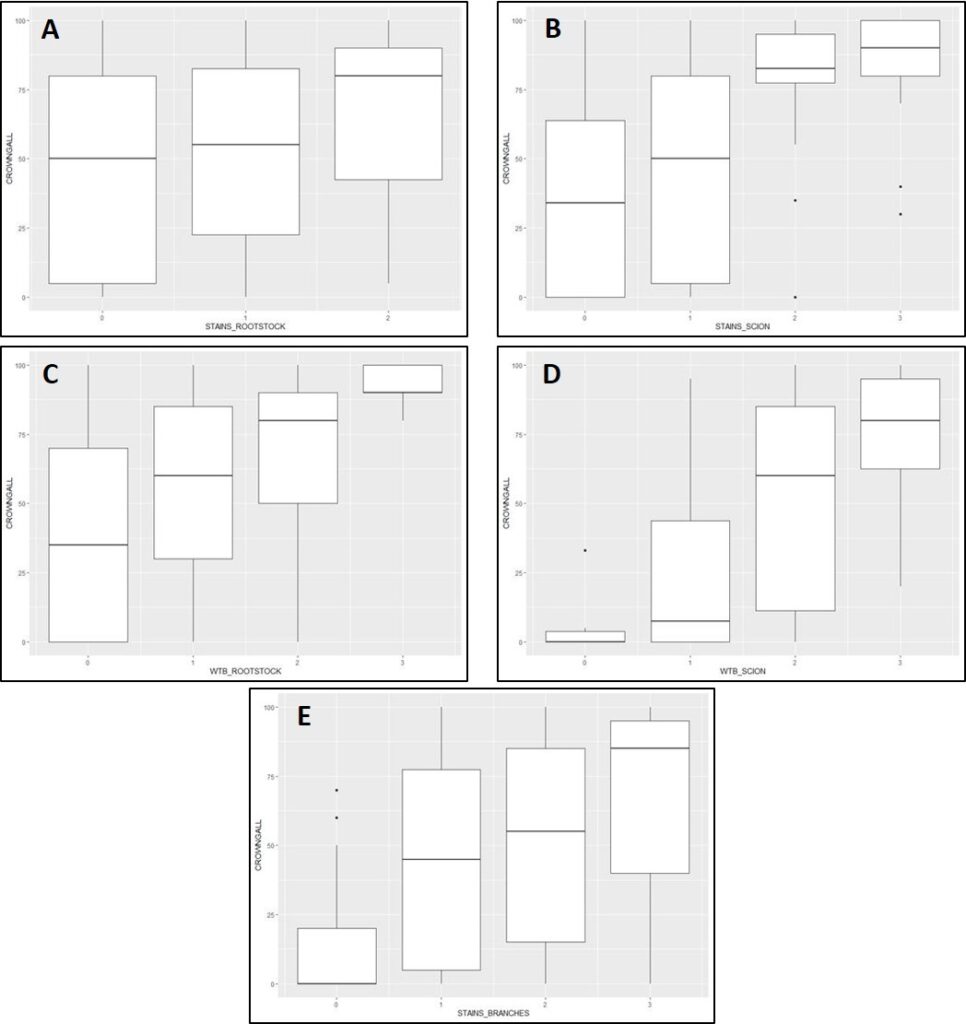
Spearman rank correlation analyses showed highly significant associations between crown gall severity and stains (Spearman ρ = 0.4669; P<0.0001), as well as between crown gall severity and WTB holes (Spearman ρ = 0.7637; P<0.0001), indicating that trees with greater crown gall severity also had greater TCD symptom severity. Not surprisingly, the relationship between stains and WTB holes was highly significant (Spearman ρ = 0.5869; P<0.0001). There was significant negative correlation between crown gall severity and DBH (Spearman ρ = -0.2909; P<0.0001), and between WTB holes and DBH (Spearman ρ = -0.1504; P<0.0335). Stains and DBH were not correlated and the relationship statistically insignificant. These results suggest that trees in a mature orchard with history of crown gall and TCD have reduced girth of the scion (main trunk).
Development of an isothermal PCR assay for detection of Geosmithia morbida. Although not stated in the original project objectives, we completed development of a qualitative recombinase polymerase amplification (RPA) assay for G. morbida in which dual-labeled translation elongation factor 1-alpha (TEF1-α) amplicons are detected with a lateral flow strip. The rationale for this work is that diagnosis of TCD by fungal isolation on agar media and morphological identification can be confounded by the presence of morphologically similar, nonpathogenic Geosmithia species as well as other fungi, and requires a high level of expertise. Thus, a molecular diagnostic technique using scrapings from complex cultures emerging from infected bark tissue pieces on agar media or directly from crude extracts of infected bark tissue, will augment and possibly simplify diagnoses. The latter has the possibility of application in the field by plant health and crop professionals. The primer/probe combination we designed and selected successfully identifies all tested isolates of G. morbida at DNA concentrations of 100 pg/µL, and can discriminate G. morbida from other Geosmithia species as well as other fungi often associated with walnut bark cankers (Figure 9). One isolate was chosen for serial dilution and was identified at DNA concentrations as low as 100 fg/µL. Furthermore, the assay was used successfully to test crude extracts from fresh lesions in inoculated walnut bark. The manuscript describing this work is in final revision and will be resubmitted to Plant Disease soon.
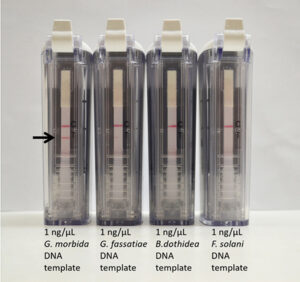
Key research findings summary
- There is a peak flight period beginning late May/early June that often extends into July. There can also be another period of flight activity later in the summer, beginning in August and extending through late October.
- The repellent combination R-(+)-limonene and trans-conophthorin has an effective distance of about 2 m from a point source, and in some cases 4 m, making single-tree deployment during periods of peak WTB flight activity the most likely format if the repellent combination is to be used successfully in a commercial orchard.
- Trees with crown gall disease are at high risk of WTB attack and TCD, and would be prime candidates to protect with repellent.
- The WTB can emerge from crown galls and carry the crown gall bacterium Agrobacterium tumefaciens. It seems unlikely that WTB is a vector that can transmit crown gall disease since all tumefaciens isolated from the tumor-emergent WTB were avirulent.
- A qualitative recombinase polymerase amplification (RPA) assay for G. morbida was developed that provides an additional tool for diagnosis of TCD.
- The results of our study will help inform management decisions to sustain long-term orchard health in that they may provide a basis for assessing tree risk to TCD and deploying the repellent.
Recommendations for future research and outreach
The unanticipated challenges we experienced from the outset of the project prevented addressing the objectives as originally conceived and proposed. The following recommendations include aspects that we had hoped to address, as well as others that derive from discoveries and successes of the project.
- We were unable to examine other factors besides crown gall that may potentially predispose walnut trees to WTB attack and TCD. Episodic water stress, soil salinity and other diseases such as shallow bark canker and nematode injury are possibilities that could be studied in the future.
- Related to recommendation 1 is how predisposing factors influence host apparency to WTB and susceptibility to TCD. For example, are there discernible changes in bark chemistry that increase WTB attraction and/or that compromise host defenses against pathogen ingress and canker severity? For example, this could be investigated experimentally by examining changes in bark chemistry and innate immunity responses in young trees inoculated with crown gall bacteria.
- The biological significance of our finding that tumor-emergent WTB can carry Agrobacterium tumefaciens could be further examined by a) a more intensive survey of tumor-emergent WTB to see if they carry virulent isolates of tumefaciens bearing the Ti plasmid, and b) studies with WTB artificially- and naturally-contaminated with virulent A. tumefaciens to see if they can transmit the pathogen to Juglans species to cause crown gall.
- Larger long-term trials in experimental and commercial walnut orchards are needed to assess the efficacy of the repellent combination and its cost vs. benefit for orchard health. This, in part, is contingent on the level of interest among growers and support from the California walnut industry for future research on TCD. The industry faces many challenges, including other pests and diseases as well as current market conditions, that are viewed with higher priority than TCD. In addition to economic considerations, the future use of the repellent is also contingent on a supplier interested in further developing and producing it for commercial distribution, as was done for the MBO bait.
- The UCCE walnut research community includes orchard systems farm advisors and specialists actively engaged in extension and outreach to English walnut growers and orchard managers throughout California. Our research discoveries and information products are available and will be used by this community to raise awareness about TCD.
Participation of producers: The principal role of the three growers in our research study was to permit and guide our access to their orchards, and to suggest areas in their orchards where to place our traps.
References
Anonymous. 2019. R Core Team, R: A language and environment for statistical computing. https://R-project.org/. Vienna, Austria.
Audley, J. P., Bostock, R. M., and Seybold, S. J. 2020a. Trap assays of the walnut twig beetle, Pityophthorus juglandis Blackman (Coleoptera: Curculionidae: Scolytinae), reveal an effective semiochemical repellent combination. J. Chem. Ecol. 46:1047-1058.
Audley, J. P., Homicz, C. S., Bostock, R. M., and Seybold, S. J. 2020b. A study of landing behaviour by the walnut twig beetle, Pityophthorus juglandis, among host and nonhost hardwood trees in a northern California riparian forest. Agric. For. Entomol. 22:338-348.
Audley, J. P., Dallara, P. L., Nelson, L. J., Hamud, S. M., Bostock, R. M., and Seybold, S. J. 2020c. Trapping failure leads to discovery of potent semiochemical repellent for the walnut twig beetle. J. Econ. Entomol. 113:2772-2784.
Blood, B. L., Klingeman, W. E., Paschen, M. A., Hadziabdic, E., Couture, J. J., and Ginzel, M. D. 2018. Behavioral responses of Pityophthorus juglandis (Coleoptera: Curculionidae: Scolytinae) to volatiles of black walnut and Geosmithia morbida (Ascomycota: Hypocreales: Bionectriaceae), the causal agent of thousand cankers disease. Environ. Entomol. 47:412-421.
Chen, Y. G., and Seybold, S. J. 2014. Crepuscular flight activity of an invasive insect governed by interacting abiotic factors. PLoS One 9:15.
Homicz, C. S., Audley, J. P., Chen, Y., Bostock, R. M., Tauber, C. A., and Seybold, S. J. 2021. Walnut twig beetle landing rates differ between host and nonhost hardwood trees under the influence of aggregation pheromone in a northern California riparian forest. Agric. For. Entomol. 23:111-120.
Seybold, S. J., Dallara, P. L., Hishinuma, S. M., and Flint, M. L. 2013. Detecting and identifying the walnut twig beetle: Monitoring guidelines for the invasive vector of thousand cankers disease of walnut. in: University of California Agriculture and Natural Resources, Statewide Integrated Pest Management Program, Oakland, California.
Seybold, S. J., Dallara, P. L., Nelson, L. J., Graves, A. D., Hishinuma, S. M., and Gries, R. 2015. Methods of monitoring and controlling the walnut twig beetle, Pityophthorus juglandis. United States Patent Publication Number 2013/0014428A1. United States Patent and Trademark Office. United States.
Seybold, S. J., Fichtner, E. J., Lampinen, B. D., Leslie, C. A., Hasey, J. K., Y., C., and Bostock, R. M. 2016. Impact of walnut twig beetle on English walnut health, productivity, and management: A synthesis of biotic and abiotic methods of assessment.
Yakabe, L. E., Maccree, M. M., Sudarshana, P., McClean, A. E., Parker, S. R., Wechter, W. P., Presting, G., Marutani-Hert, M., and Kluepfel, D. A. 2012. Novel PCR primers for detection of genetically diverse virulent Agrobacterium tumefaciens biovar 1 strains. Journal of General Plant Pathology 78:121-126.
Research Outcomes
Education and Outreach
Participation Summary:
- Discussion of TCD and recent research findings at Statewide Virtual Walnut Series, 22 February 2022, presented by Dr. Kari Arnold within her talk entitled “Identifying Diseases of Walnut and Management Strategies” (information provided and talk attended by Dr. Bostock; Virtual Day 1 program is attached VIrtual Day 1). Although the SARE evaluation form could not be used for this outreach event, attached is the “Impacts and Demographics…”Impacts and Demographics Statewide Virtual Walnut Series 2022 summary for the program (courtesy of Dr. Arnold). There were ~194 attendees that included pest control advisors (PCAs), certified crop advisors (CCAs), private applicators, crop consultants, orchard managers, orchard owners, orchard employees, and others.
- Dr. Bostock and Ms. Siefker were interviewed by Vicky Boyd, a contributing writer for the online trade magazine “West Coast Nut”, for a feature article entitled “Death By A Thousand Cankers” that appeared in the March 2022 issue. Our funding support by Western SARE was acknowledged in the article. This magazine has a wide readership in the industry in the western USA. West Coast Nut article
- Scientific journal articles: The research papers published during year one of the project have the following citation scores in Google Scholar (as of 14 April 2022).
- Audley JP, Bostock RM, Seybold SJ. 2020. Trap assays of the walnut twig beetle, Pityophthorus juglandis Blackman (Coleoptera: Curculionidae: Scolytinae), reveal an effective semiochemical repellent combination. J. Chem. Ecol. 46:1047-1058. 4 citations
- Audley JP, Homicz CS, Bostock RM, Seybold SJ. 2020. A study of landing behaviour by the walnut twig beetle, Pityophthorus juglandis, among host and nonhost hardwood trees in a northern California riparian forest. Agric. For. Entomol. 22:338-348. 6 citations
- Audley JP, Dallara PL, Nelson LJ, Hamud SM, Bostock RM, Seybold SJ. 2020. Trapping failure leads to discovery of potent semiochemical repellent for the walnut twig beetle. J. Econ. Entomol. 113:2772-2784. 6 citations
- Homicz CS, Audley JP, Chen Y, Bostock RM, Tauber CA, Seybold SJ. 2021. Walnut twig beetle landing rates differ between host and nonhost hardwood trees under the influence of aggregation pheromone in a northern California riparian forest. Agric. For. Entomol. 23:111-120. 0 citations
- Two PowerPoint modules with updated information on thousand cankers disease tailored for general audiences were completed.
Education and Outreach Outcomes
- TCD biology and etiology; recent research findings; impact in California walnut orchards.